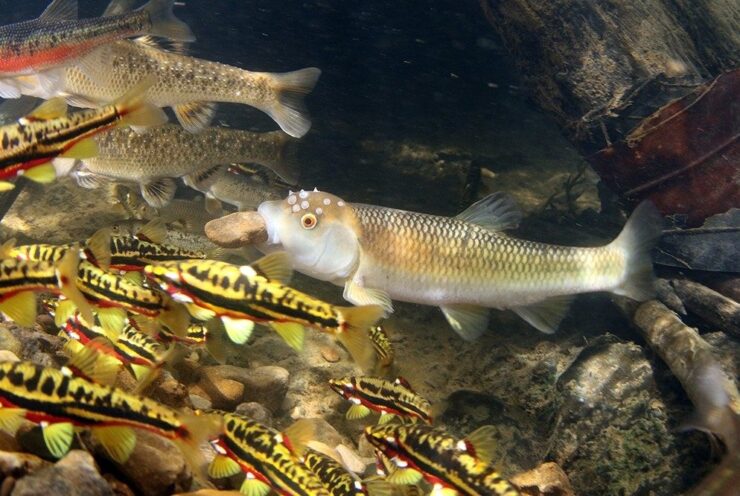The bluehead chub has a stocky body and a very large head covered with tubercles. They have olive to brown sides often with dorsal and caudal fins orangish.
The fish pictured above is a male which can be easily identified during the breeding season because their head turns blue. The average adult size is about 5 to 6 inches long.
Bluehead chubs live in cool clear rocky streams and feed on insects and plant material. Not sure of the exact range but roughly from Virginia to Louisiana in suitable habitat.
Habitat and Distribution
Geographic Range
- Range: Atlantic and Gulf Slope drainages from Shenandoah River, Virginia, to Pearl River, Mississippi
- Habitats:
- Rocky and sandy pools
- Headwaters
- Creeks
- Small to medium rivers
Environmental Preferences
The Bluehead Chub thrives in clear, well-oxygenated waters with moderate currents. It typically resides above the Fall Line but can be found below it in Alabama. This preference for specific environmental conditions highlights its role as an indicator species for healthy freshwater ecosystems.
Physical Characteristics
- Size: 70-160 mm in length
- Body Shape: Robust, stout, and deep-bodied
- Mouth: Large, slightly subterminal with small barbels
- Color: Brassy-green with a dusky stripe along the sides
- Breeding Male Traits: Striking blue head and tubercle-like structures
The distinctive blue head of breeding males is one of the most recognizable features of the Bluehead Chub. This physical change plays a significant role in its reproductive behavior.
Reproductive Behavior
- Seasonal Changes: Males develop blue heads and tubercles
- Nest Construction: Males build nests using pebbles and stones
- Egg Laying: Females lay eggs in the nests
- Nest Guarding: Males protect the nests and ensure egg-hatching
The breeding season transforms the males both in appearance and behavior, making them more aggressive and protective of their nests. This ensures the survival of the offspring in a competitive environment.
Feeding Habits
- Insects
- Small crustaceans
- Plant material
The Bluehead Chub has a varied diet that supports its growth and reproductive success. By consuming different food sources, it helps maintain ecological balance within its habitat.
Key Facts About the Bluehead Chub
- Unique Feature: Breeding males develop a striking blue head
- Reproductive Strategy: Males build and guard nests to protect eggs
- Diet: Omnivorous, feeding on insects, small crustaceans, and plant material
- Habitat: Prefers clear, well-oxygenated streams and rivers
- Role in Ecosystem: Keystone species contributing to habitat creation and biodiversity
- Predators: Larger fish species, birds, and occasionally mammals prey on Bluehead Chubs. Common predators include largemouth bass, herons, and raccoons.
Interaction with Humans
The Bluehead Chub is sometimes encountered by anglers during recreational fishing. While not typically targeted as a game fish, its presence serves as an indicator of healthy freshwater ecosystems. Conservationists and researchers study this species to monitor the health of aquatic habitats and develop strategies for their protection.
Conclusion
The Bluehead Chub, Nocomis leptocephalus, is a vital species within North America’s freshwater ecosystems. Its unique physical characteristics, intricate reproductive behaviors, and essential ecological roles underscore the importance of conserving this species.

